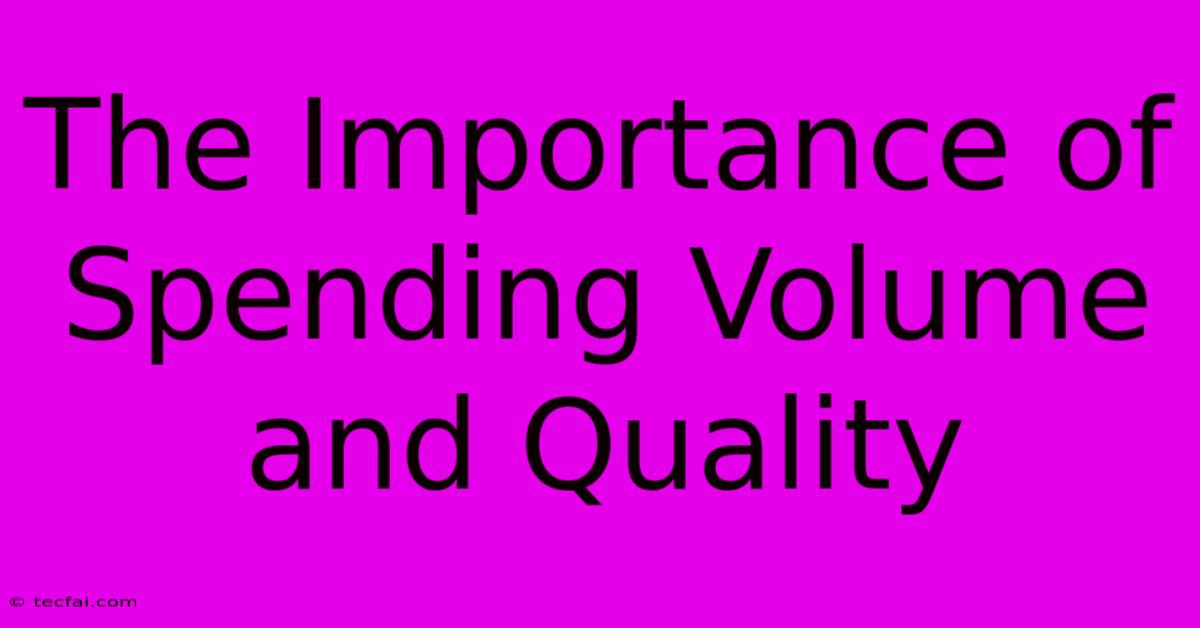The Importance Of Spending Volume And Quality

Discover more detailed and exciting information on our website. Click the link below to start your adventure: Visit Best Website tecfai.com. Don't miss out!
Table of Contents
The Importance of Spending Volume and Quality: A Balanced Approach to Financial Success
In the world of personal finance, we often hear about the importance of saving money. While saving is crucial for financial security, it's equally important to understand the interplay between spending volume and spending quality. Simply put, it's not just how much you spend, but also what you spend it on that determines your overall financial well-being. This article delves into the significance of both aspects and how to strike the right balance.
Understanding Spending Volume: The "How Much"
Spending volume refers to the total amount of money you spend within a given period, typically a month or a year. Tracking your spending volume is the first step towards understanding your financial health. High spending volume doesn't automatically equate to bad financial management; it depends heavily on your income and savings. A high earner with significant savings might have a high spending volume without experiencing financial strain. However, for individuals with limited income, a high spending volume can quickly lead to debt and financial instability.
Tools for Tracking Spending Volume:
- Budgeting Apps: Numerous apps (Mint, YNAB, Personal Capital) allow for easy tracking and categorization of expenses.
- Spreadsheet Software: Excel or Google Sheets offer customizable templates for detailed expense monitoring.
- Manual Tracking: A simple notebook and pen can be surprisingly effective for those who prefer a hands-on approach.
The Significance of Spending Quality: The "What"
Spending quality focuses on the value you receive for your money. This isn't just about purchasing luxury items; it's about making conscious spending decisions that align with your values and long-term goals. High-quality spending often involves investments that appreciate in value over time, contribute to personal growth, or improve your overall well-being. Conversely, low-quality spending involves impulsive purchases, unnecessary expenses, and items that provide little lasting value.
Examples of High-Quality Spending:
- Education and Skill Development: Courses, workshops, and certifications that enhance your career prospects.
- Health and Wellness: Gym memberships, healthy food, and regular medical checkups.
- Experiences: Travel, concerts, and other activities that create lasting memories.
- Durable Goods: Investing in high-quality items that last longer, reducing the need for frequent replacements.
Examples of Low-Quality Spending:
- Impulsive Purchases: Buying items you don't need or want, often driven by emotions or advertising.
- Unnecessary Subscriptions: Paying for services you rarely use.
- Fast Fashion: Purchasing cheap, low-quality clothing that quickly wears out.
- Excessive Eating Out: Regularly dining at expensive restaurants instead of cooking at home.
Finding the Right Balance: A Holistic Approach
The key to financial success lies in finding the right balance between spending volume and spending quality. It's not about extreme frugality; it's about making informed decisions that align with your financial goals. Here are some strategies to achieve this balance:
- Create a Realistic Budget: Track your income and expenses to understand where your money is going.
- Prioritize Needs Over Wants: Distinguish between essential expenses and discretionary spending.
- Set Financial Goals: Having clear goals (e.g., saving for a down payment, paying off debt) provides motivation for mindful spending.
- Practice Delayed Gratification: Avoid impulsive purchases by waiting a period before making a significant purchase.
- Review and Adjust Regularly: Your financial situation and priorities will change over time, so regular budget reviews are essential.
By understanding and managing both spending volume and spending quality, you can achieve a more fulfilling and financially secure future. It's not about deprivation; it's about making conscious choices that contribute to your overall well-being and long-term financial success. Remember, financial health is a marathon, not a sprint, requiring consistent effort and mindful spending habits.

Thank you for visiting our website wich cover about The Importance Of Spending Volume And Quality. We hope the information provided has been useful to you. Feel free to contact us if you have any questions or need further assistance. See you next time and dont miss to bookmark.
Featured Posts
-
Contrasting Views On Youth Strategy Funds
Dec 03, 2024
-
Serena Williams Second Child Doubts About Love
Dec 03, 2024
-
Gerwyn Price Declines Premier League Darts
Dec 03, 2024
-
East 17 Bitter Fallout Revealed
Dec 03, 2024
-
Adira Serenas Tough Daughter
Dec 03, 2024
